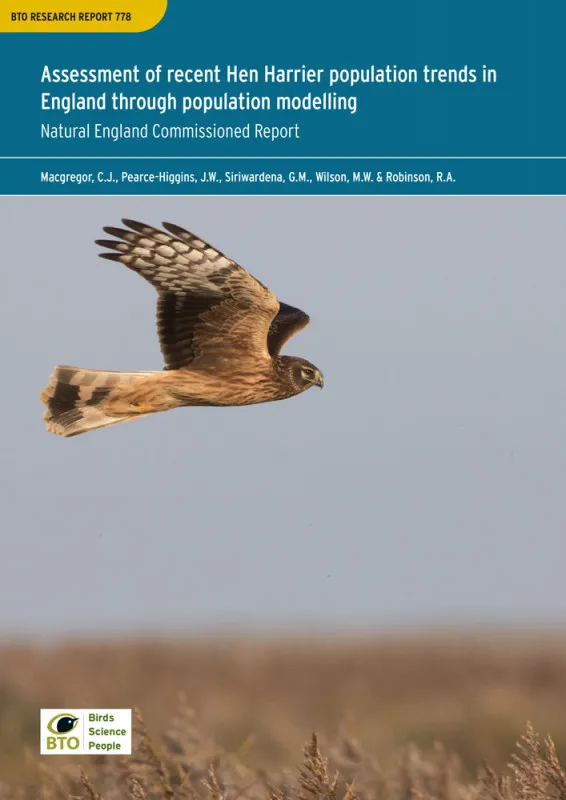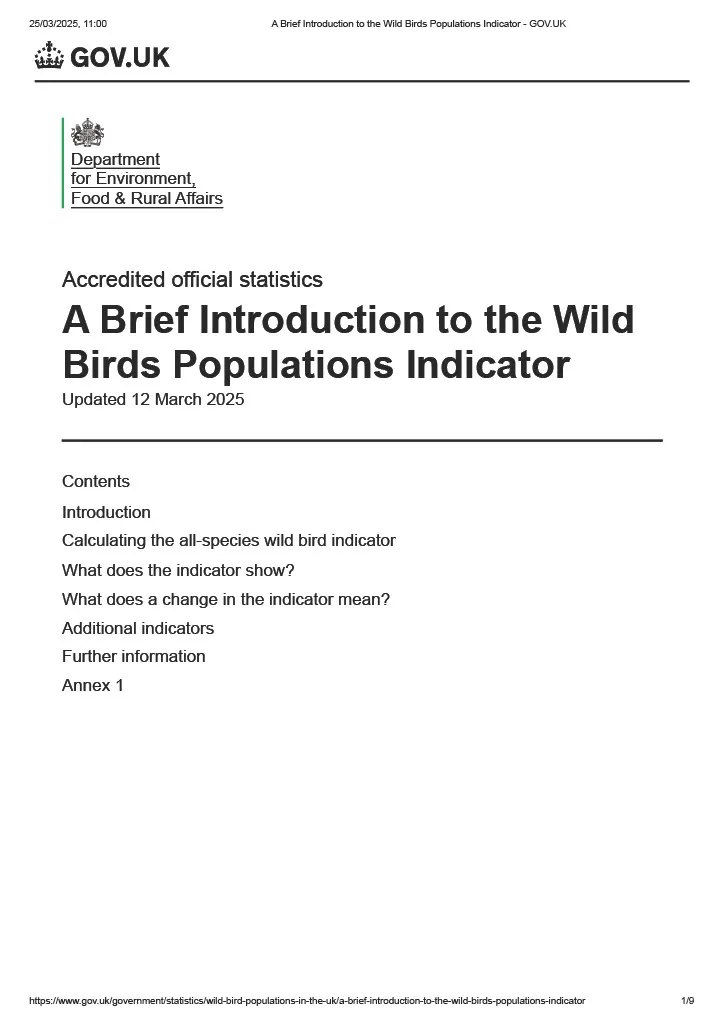BTO Research Reports are scientific papers that have been self-published by the BTO. The following is a full list of the published BTO research reports. Most are free to download, and links to Abstracts are included where possible.
Numbers missing from the list are those allocated but which were never produced or which have not been published. BTO recognises that, particularly in respect of commercially sensitive cases, a period of confidentiality is appropriate for some projects. However, in the interests of scientific development and dissemination of information, we encourage clients to permit publication as soon as it is reasonable to do so.
- If you wish to purchase a physical copy of a report please contact researchreports@bto.org.
- More information about our Annual Service reports to JNCC 1992-2005.
Assessment of recent Hen Harrier population trends in England through population modelling
This study uses a population modelling approach to explore the effects of changes in rates of productivity, survival, and settlement on population growth in the English population of Hen Harriers.

Search
Wild Bird Indicators
Author:
Published:
The Wild Bird Indicators are part of the government’s suite of biodiversity indicators, alongside indicators related to measures of habitat condition, air pollution, river water quality, extent of protected areas, spread of non-native species as well as the state of butterflies and other wildlife. The indicators are produced annually for Defra and NatureScot by BTO, together with RSPB and JNCC.The Wild Bird Indicator is an accredited Government Official Statistic, and further information on its construction and how it is developed can be found on the government website. The Wild Bird Indicators are based on population trends of bird species that are native to, and breed or spend the winter in, the UK. These population trends are calculated largely using data that is collected by volunteers, as part of national bird monitoring schemes like the BTO/RSPB/JNCC Wetland Bird Survey and the BTO/JNCC/RSPB Breeding Bird Survey. The indicators therefore link the efforts of our dedicated volunteers directly to a policy-relevant assessment of the state of nature.The indicators group breeding birds by habitat: farmland, woodland, uplands, waterways and wetlands, and marine and coastal areas, and most are based on datasets that stretch as far back as 1970. This means that indicators are a useful tool for examining how birds associated with different landscapes have fared over many decades. The indicators also report on the state of our internationally important wintering (i.e. non-breeding) wetland and coastal birds.
Reports Indicators UK

Modelling population‐level impacts of wind farm collision risk on Welsh Red Kites
Author:
Published:
The Welsh Red Kite population is currently undergoing rapid growth, following a historic decline driven by persecution. Wind turbines represent a modern threat to Red Kites, causing additional mortality through collisions, and numerous new wind farms are currently proposed and at various stages of development. We used Population Viability Analysis to model the potential impacts of current and proposed wind farm developments on the Welsh Red Kite population. Modelling used spatially‐explicit population estimates, together with combinations of upper, lower and intermediate values for each demographic parameter. A rejection‐sampling procedure was applied to retain a final model set, whose range of population trajectories reflected the observed recent population trend of Red Kites in Wales. Different scenarios of wind turbine collision mortality were applied, to assess impacts at the national(Wales) scale, regional scale, and within the Elenydd‐Mallaen and Berwyn Special Protection Areas (SPAs). Under the baseline scenario (including existing wind turbines but no further future developments), all models predicted future population stability or increase, at all spatial scales. Impacts of additional wind turbines on population growth were small, although over time these propagate into substantial differences in population size. In general, modelled impacts of proposed developments were larger at smaller spatial scales with larger Red Kite populations (e.g. the two SPA populations). These results may provide reassurance that currently‐proposed levels of wind farm development are unlikely to prevent the continued growth of the Welsh Red Kite population. However, they also highlight impacts on the ultimate size of the Red Kite population in the longer term, and that greater caution is justified for developments in proximity to the two SPAs, in order to minimize risk to the populations within, and particularly around the fringes of, these specifically‐protected areas.NotesThe authors acknowledge the provision of data and related resources by Natural Resources Wales ( (c) NRW and Database Right), Ordnance Survey (License no. AC0000849444), and Crown Copyright / Database Right, as well as funding and data provided by the nine wind farm development companies involved in this study, coordinated by RenewableUK Cymru.
Papers